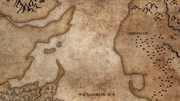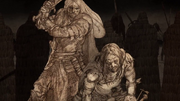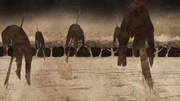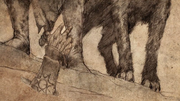No edit summary |
No edit summary |
||
| Line 10: | Line 10: | ||
|result=*All of Westeros south of the Neck is conquered by the Andals |
|result=*All of Westeros south of the Neck is conquered by the Andals |
||
*[[The North]] successfully repulses the Andals. |
*[[The North]] successfully repulses the Andals. |
||
| − | *[[Children of the Forest]] all but exterminated, handful of survivors |
+ | *[[Children of the Forest]] all but exterminated, handful of survivors flee [[beyond the Wall]]. |
|battles= |
|battles= |
||
|side1=*Kingdoms of the [[First Men]] |
|side1=*Kingdoms of the [[First Men]] |
||
Revision as of 22:41, 24 June 2012
The Andal Invasion was the migration of the Andals to the continent of Westeros from their homeland of Andalos on the eastern continent of Essos, six thousand years before the War of the Five Kings. The migratory invasions of the Andals occurred in waves over many centuries, but by the end they had killed or conquered all of the First Men south of the Neck. By the end of the invasions, the Andals had displaced the First Men as the major ethnic and cultural group of Westeros, to the point that peoples living in Essos frequently refer to Westeros as the Land of the Andals.
Prelude

Andalos in Essos
The Andals were a tall, fair-haired race whose original homelaAccording to Andal legend, the God of Seven revealed itself to them in their original homeland, the Hills of Andalos, and from this they developed a new religion, the Faith of the Seven. Not long afterward, spurred on by the zeal of their new faith, the Andals set sail across the Narrow Sea to conquer Westeros. Many Andal warriors displayed their devotion by carving a Seven Pointed Star into their flesh, the symbol of their religion.
Invasion
The Andals first came ashore in the Fingers, in what would later be known as the Vale of Arryn. According to legend, Ser Artys Arryn, dubbed "the Winged Knight", flew atop a giant falcon to the topmost mountain of the Vale and defeated the Griffin King, a member of the First Men dynasty of the Mountain Kings.

The Andals defeated the First Men throughout the South
From their initial landing in the Vale, the Andal migrations spread out in waves across Westeros, in a process lasting many centuries. The First Men were armed with weapons made of bronze, but the Andals introduced iron and steel weapons to the continent for the first time. Andal military tactics focused on concepts of "knighthood", producing elite warriors known as "knights" who wore full suits of iron armor while riding into battle on heavy horse. The related concept of "chivalry" spurned on the knights, a code of knightly devotion tied to the Faith of the Seven. The First Men could not withstand the armored shock cavalry assaults of the Andals' knights.[2]
Over the centuries, the Andals conquered all of Westeros except for the North, where the Kings in the North from the line of House Stark were able to resist their advance. Any approach to the North has to go through the bottleneck the Neck, a narrow isthmus of land filled with swamps. The ancient fortress of Moat Cailin commands the only major road coming up from the south, making it an ideal choke point for the First Men of the North. For centuries, Andal armies smashed against Moat Cailin like water on rock, but to no avail, and the North remained unconquered.

The Andals burned the weirwoods and slaughtered the Children of the Forest
The Andals viewed the magic of the Children of the Forest as an abomination before the God of Seven. They slaughtered the Children of the Forest wherever they encountered them, and burned the sacred weirwood trees throughout southern Westeros. The Children of the Forest were never very numerous to begin with, and during the Long Night fighting against the White Walkers they took heavy losses from which they never truly recovered. The Andal Invasion exterminated the few Children of the Forest that remained in Westeros, and after this point they dropped out of history, to the point that six thousand years later many believed they never existed at all. According to rumors and legend, the handful of surviving Children of the Forest fled to the furthest north in the Lands Beyond the Wall, where they knew the Andals would never follow them.
Aftermath

The Andals are repulsed by the Kings in the North
The North held out, but otherwise the Andals became the dominant cultural group in Westeros.
After many centuries the "invasions" ceased as the new Andal kingdoms carved out of southern Westeros stopped acting in a unified manner and began fighting each other. While wars between the North and southern kingdoms did sporadically take place for thousands of years after this, they were not "invasions" so much as "politics" as usual. The Andal-held Kingdom of the Rock in the Westerlands was just as likely to go to war against the First Men of the North, as they were to go to war against their fellow Andals in the Kingdom of the Reach. After many thousands of years, the religions of the Old Gods and of the New Gods (the Seven) settled into a grudging co-existence. Wars of religion between the followers of the Old Gods and those of the Faith of the Seven have thus not occurred in thousands of years.
The Iron Islands are somewhat of an odd case, in that the Andals who conquered it "went native" and just assimilated into the distinctive Ironborn culture of seafaring and piracy. They even abandoned worship of the Seven and adopted the local religion of the Drowned God. Thus the Ironborn are ethnically similar to the Andal/First Men mix that the rest of the South possesses, but they are culturally distinct.
Dorne was also conquered by the Andals and they intermingled with the First Men there, but they remained as numerous petty fiefdoms and didn't unify.
In the books
When the Andals arrived in the Riverlands, they were divided up into several local kingdoms of the First Men, including ones ruled by House Blackwood, House Bracken, and House Mudd. House Tully also dates back to the time of the First Men, though they did not rule as kings. When the Andals arrived, House Mudd fought against them but in the end was completely destroyed, and their castle left a ruin. Meanwhile, the Blackwoods, Brackens, and Tullys intermarried with the Andal invaders. Indeed, this only served to further the Blackwood-Bracken feud: the Blackwoods tenaciously clung to their worship of the Old Gods, but the Brackens converted to the religion of the Andal invaders.
The Andals did conquer the region of Dorne, but they did not unify it. Dorne remained a patchwork of dozens of small independent fiefdoms for thousands of years. As in many other regions of Westeros, in Dorne petty Andal kings ruled over First Men populations, with whom they intermingled and merged ethnically. Five thousand years later the Rhoynar invasion radically reshaped Dorne's ethnic and cultural makeup, but the Dornishmen inhabiting the inner mountains of Dorne are still primarily descended from the Andal invaders and the First Men.
References
- ↑ HBO season 2 viewers guide Westeros Through the Ages
- ↑ "The Complete Guide to Westeros: the Old Gods and the New"
